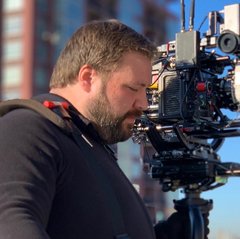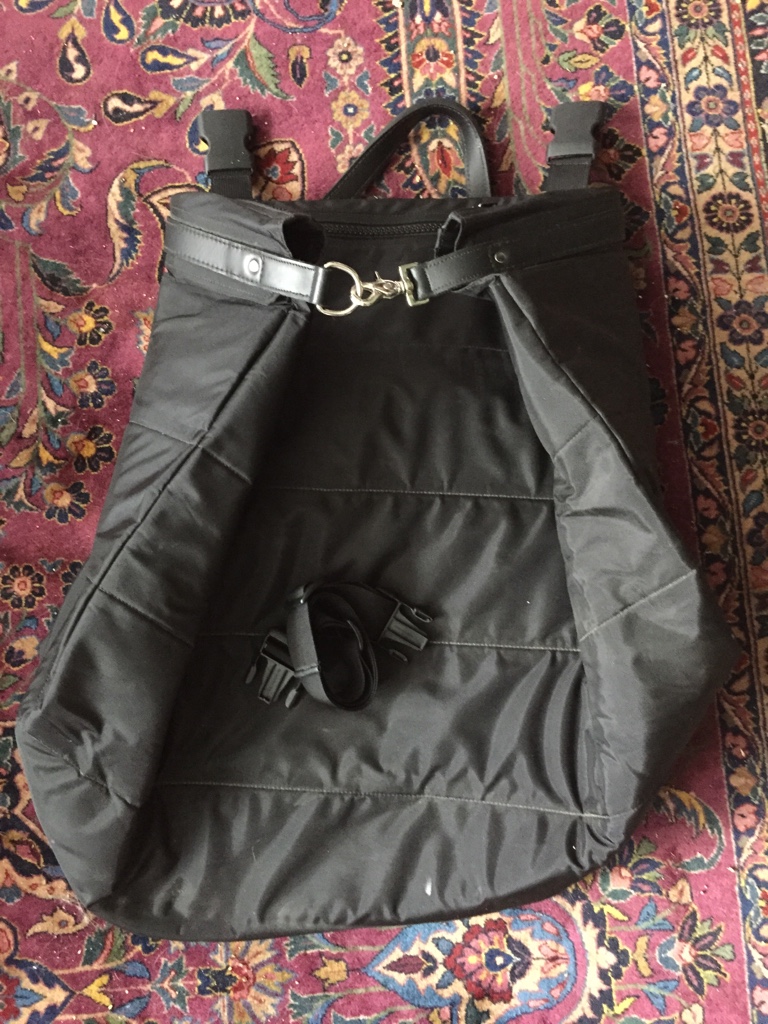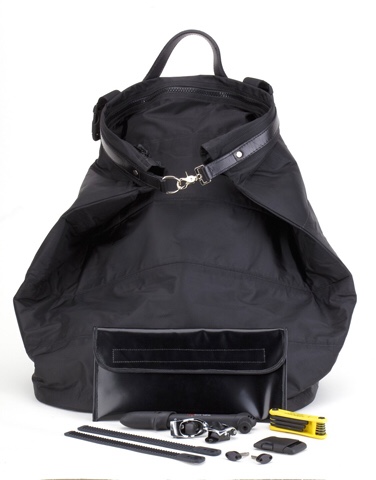-
Posts
472 -
Joined
-
Last visited
-
Days Won
55
Everything posted by Tom Wills
-
Continuing my moved-to-a-smaller-apartment summer cleanout sale, here's another deal! Anton Bauer Dual 2700 charger. Has always been a workhorse for me, but I have more chargers than batteries now. Works like the day I bought it. No discharger module installed, but I have another one with a discharger I could part with instead, for a little extra cash. Has Firmware 5.4, and will charge Dionic HCs and similar. Asking $350 OBO.
-
Here’s a little gadget I called the Boomerang - it mounts to the AB plate on the back of your camera, and gives you a lightweight but strong 1/4” mount. It’s made of aluminum, and bored out to reduce the weight. It’s a perfect transmitter mount for the back of the camera. This is a one-off part I hand-made for this, which I don't use enough to keep in my kit right now. It has some scuffed paint on it, but it works perfectly. Asking $175 OBO. Email me at willsvideo@gmail.com
-

Used Decimator 2 For Sale
Tom Wills replied to Tom Wills's topic in Steadicam Marketplace - For Sale
Sold! -

Decimator to Anton Bauer Mount for Cinetronic
Tom Wills replied to Tom Wills's topic in Steadicam Marketplace - For Sale
Thanks Alec! Already spoken for - and Rich has his! (This is the backup in case the anodizer messed up his!) SOLD.- 3 replies
-
- Decimator
- Cinetronic
-
(and 3 more)
Tagged with:
-
This trusty beast has been to battle with me many a time, but for the past year, it's been retired to my backups case, so it deserves a new home. This is a Decimator 2 - SDI to Composite downconverter, and SDI to HDMI cross-converter. Never needed to be serviced, never blown up. There are a few scratches and dings, and some of the lettering has worn off, but it worked perfectly the last time I needed it. Keep a backup for using your TB-6 CRT, or use it to turn an HDMI LCD into an SDI monitor (what this was often used for). Comes with the original AC adaptor, and I can toss in a homemade GPI PRO 4 pin LEMO to Decimator Power/Video cable for an extra $50. Paid $500 in 2011. Asking $200 without the LEMO cable, $250 with. Email me at willsvideo@gmail.com.
-
This is an extra plate I made when making a few of these recently - it's a plate to mount Decimator MD-HX converters (as well as MD-CROSS and similarly shaped "new" Decimators) to the back of Cinetronic and other monitors using their AB Battery mount. Bolt it to your converter and snap it on, and you don't have to worry about PSF issues or compatibility anymore (no Velcro necessary!). Comes in a beautiful chalkboard black anodized finish. Likely to be the last one I have of these for a few weeks. Asking $200 shipped via USPS Priority (2 days inside the US). Email me at willsvideo@gmail.com. See picture of it in use here: http://www.steadicamforum.com/index.php?showtopic=22727&p=111922
- 3 replies
-
- Decimator
- Cinetronic
-
(and 3 more)
Tagged with:
-

Walter Klassen Harness Bag (Old Style) - Mint!
Tom Wills replied to Tom Wills's topic in Steadicam Marketplace - For Sale
Sold! Thanks Ron! -
This is an old style Walter Klassen harness bag. It's made of very heavy duty Cordura fabric, padded, and has real leather trimming and handle. This is one of the most durable bags I've seen - it's been shipped and tossed by baggage handlers in airports without issue! Looks absolutely new, apart from a bit of dust from sitting in my shop for a few months. Second picture is for reference only - no tools or accessories provided - just the bag! This originally cost me $400 in 2012. Looking for $175 now, plus shipping (or pickup in the PA/NY area, depending on schedule). Contact me at willsvideo@gmail.com if you're interested.
-
Greg, I have one of these levels, and while it's not in front of me, perhaps I can help with a few of those questions. Steve Wagner is the engineer behind the Wagner level. The range is user programmable, as +/- 12, 6, 4 , 3 or 2 degrees. All of those are full scale end to end, and there is an on screen indicator (a goal post of sorts - a red line) that indicates (I believe) 2 degrees of level. So at 2 degrees, the goal posts are on the edges of the display. The level does move in one LED increments, not in 4 LED jumps. This manual might also help: http://www.tiffen.com/userimages2/Steadicam/Steadicam%20Wagner%20Horizon%20Manual%20Booklet.pdf
-
I'd watch this video - see if doing the steps in it for the DB3 tension setting helps you. Possible that you just need to re-set the tension. If not, I second the idea of calling Jack!
-
Pretty sure they're 5/8" (.625" or 15.9mm).
-

rickshaw in philadelphia / camden new jersey / new york ?
Tom Wills replied to brett.mayfield's topic in Vehicles and Mounts
I've got a Klassen hard mount you can borrow/rent. I'm in Philly but could get it to you in NYC if you need. Let me know. 215-796-8938 -

Which IDX batteries to choose?
Tom Wills replied to Christopher Kechichian's topic in Batteries/Power
Wh is Watt Hours, a measurement of how long the battery will last - a 95 watt hour battery will power a 95 watt load for an hour. This is separate from the amperage capacity - which on both batteries should be the same, 10A, or 120W. There are many a wonderful battery with huge capacities that can only support 50w loads, and there are batteries like the HL9s that only have 87w of capacity, but can handle 120w loads. -

WTB - Scout/Zephyr/Flyer vest
Tom Wills replied to Frank Born's topic in Steadicam Marketplace - Wanted
Doubtful. Should be SAE, but you never know. Certainly wouldn't be anything you couldn't get from a hardware store. I'd recommend a Nylock (or sometimes labeled just Nylon Locking) nut to replace the missing one - less chance of it falling off again in the future. -

WTB - Scout/Zephyr/Flyer vest
Tom Wills replied to Frank Born's topic in Steadicam Marketplace - Wanted
Saw this on ebay, might be of interest: http://pages.ebay.com/link/?nav=item.view&alt=web&id=251766208315 -

The Oldest Arm in Use Today (as well as other fun stories about old gear)
Tom Wills replied to Beau Cuizon's topic in Arms
Not an arm, since my Pro Titan's about 2 months old at this point, but I do own a little piece of history. Got this gimbal on a sled that was an upgraded PRO 1, that had been rebuilt and upgraded quite a few times. It looked a bit odd to me (namely that it has no markings on it - I was a bit worried about whether or not it was a PRO gimbal after all!), so I asked Jack about it. Apparently, I stumbled upon owning one of the original PRO Gimbal prototypes! I've since mounted it up on one of the new quick-clamp handles, but I still have the original clamp, also anodized in that cool gold/gray anodize. Put in a new set of bearings late last year, and it's still carrying around my hodgepodge of a sled, with whatever I've been able to throw at it, smooth as the day it was built! Though there is a suspicious looking weld on the handle, which appears to have happened before the anodize. What I'd give to know that story! Fantastic to hear the stories of the old rigs here. Truly a testament to the engineering prowess of these companies. -
Here's one of those silly little things that I happened to stumble across, and really like. I found a nifty little clamp on Amazon that'll hold onto the dovetail of a PRO FIZ plate, and has a 15mm clamp on it. $22.90. Originally designed to clamp onto a hot shoe, but for some reason, it's designed with a dovetail clamp on it. It's got enough room on the screw to easily clamp onto the PRO dovetail. I've found most of the clamps from SmallRig to be better than they have any right to be for the price. The knobs are a little cheap feeling, and the overall quality isn't what you'd expect from an American made product, but this comes in at the "cheap enough for me to toss into the kit and not worry if it gets lost" price point. My Preston rarely gets used off my rig, so for the few times it does, this'll provide a nice option, rather than just bongo ties. http://amzn.com/B009A8K0JO Just thought I'd share, in case anybody else would find it useful.
-

When is the appropriate time to enroll in a workshop?
Tom Wills replied to Jonathan Tinsley's topic in Steadi-Newbies
Purchase the book. It's a fantastic read, and you'll have a solid primer when going into the workshop. Then, after the workshop, read it again. And again. And again. Speaking of which, where'd I leave my copy? -
Looks like the difference is the WPA-1 for the Sony QR version (which has the back support point), and the BPA-3 for the lower profile one, without the rear point. That lower CG looks a lot nicer to me on the BPA-3.
-
Here you are: http://www.mouser.com/ProductDetail/LEMO/FGG0B303CLAD52/?qs=sGAEpiMZZMtJvlLX7mFQSMQCKlX6Q4sC However, I would suggest that you make a 3 pin LEMO to Female P-Tap cable, rather than always having to have the 4 way P-Tap splitter on your rig. Not only can the 4-way splitter fail, requiring a re-solder job, but I've often found I only need to power one thing off of a P-Tap, and having that extra bulk of the 4-way isn't necessary all the time. Plus the splitter can go elsewhere on the rig/camera, if needed, not just where the 3 pin LEMO is.
-
Didn't look like MoVI to me, looked like Steadicam. Had a few of the little telltale things that look like Steadicam to me - like how it dealt with corners. I'd be very curious to know who it was as well. Love the opening shot, with the tilt straight down held very, very well, and gotten out of beautifully.
-

Found a Great Deal on Ebay - Steadicam Flyer System
Tom Wills replied to Bobby Holbrook's topic in Steadi-Newbies
Bobby, Just to be clear, you are the one selling this, correct? Not just someone in your exact same town? Because if so, you need to pay for a premium membership to have access to posting in the for sale section on this forum, and posting it as "found a great deal on eBay" in the newbies section is pretty sketchy.- 1 reply
-
- 1
-

-
No, if it is a standard definition PRO sled (as in it does not have a second BNC connector labeled for HDSDI), then it is composite only. The PRO 2 monitor (as well as all other green screen monitors) are also composite only.
-

Preston Motor Cable & Fuji Gear
Tom Wills replied to joe carini's topic in Steadicam Marketplace - For Sale
Joe, Is that $75 each? Or $75 for both?
















